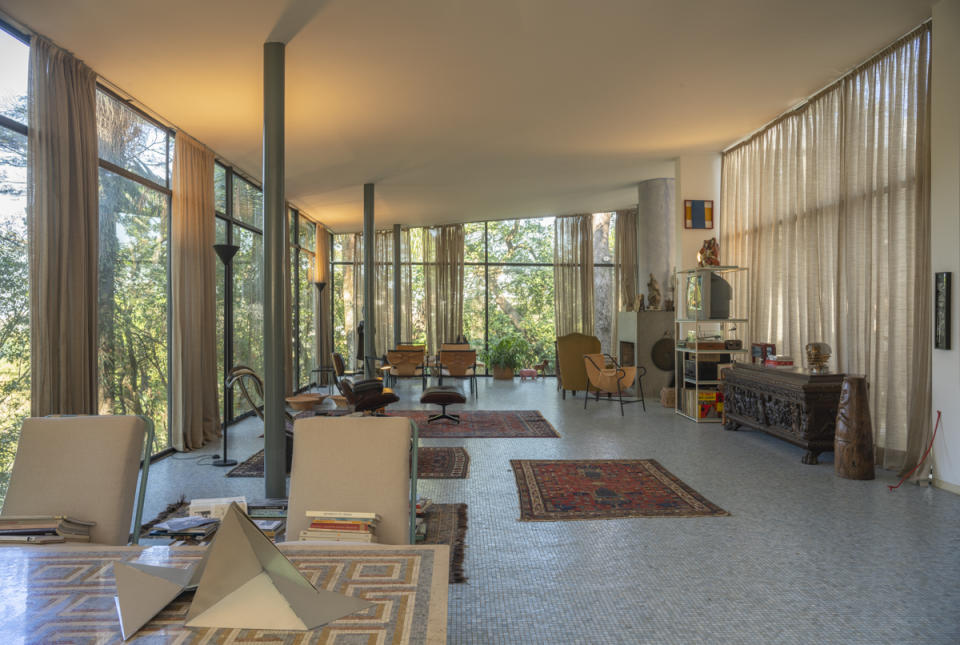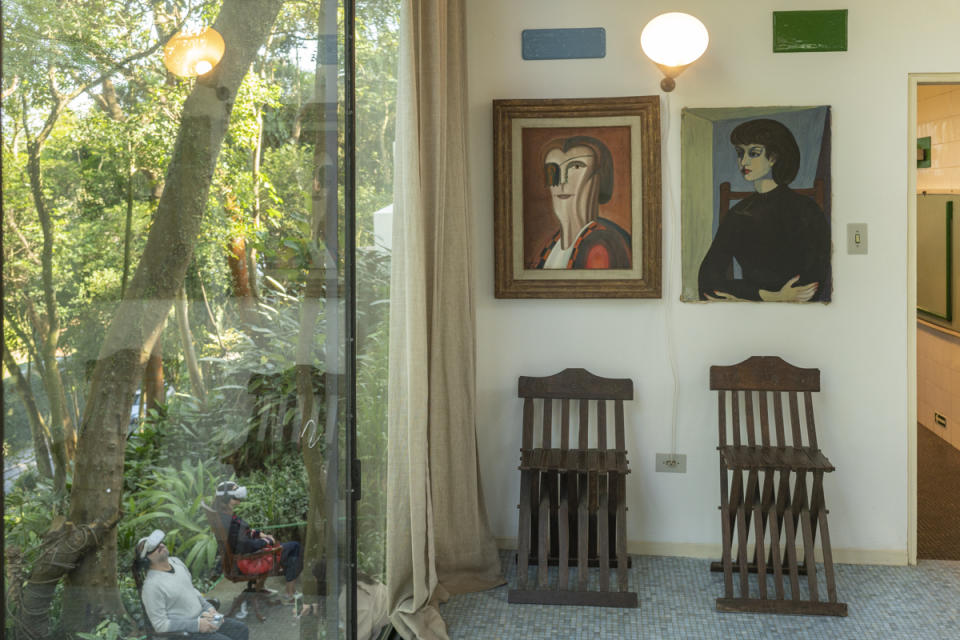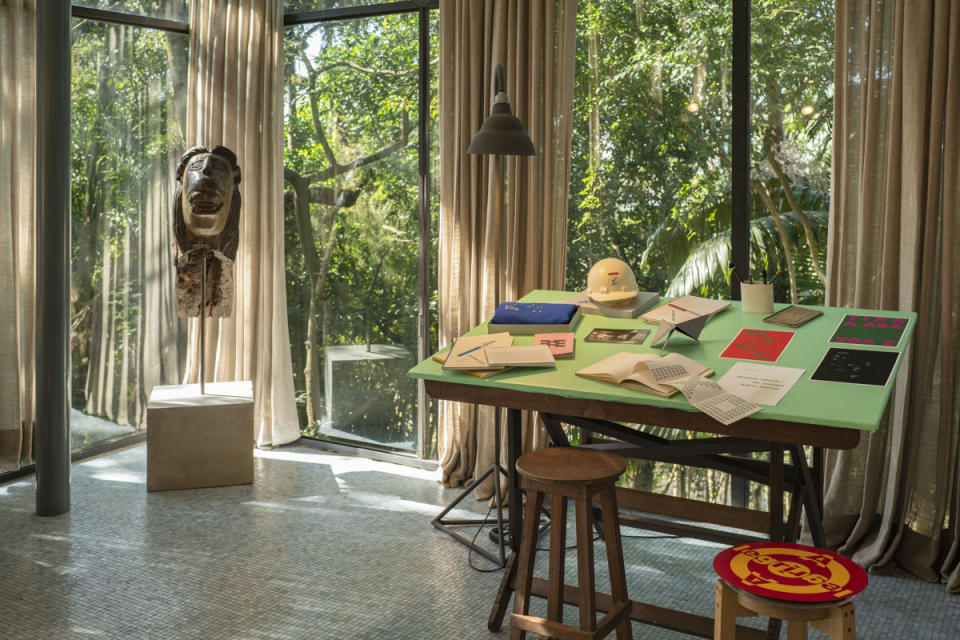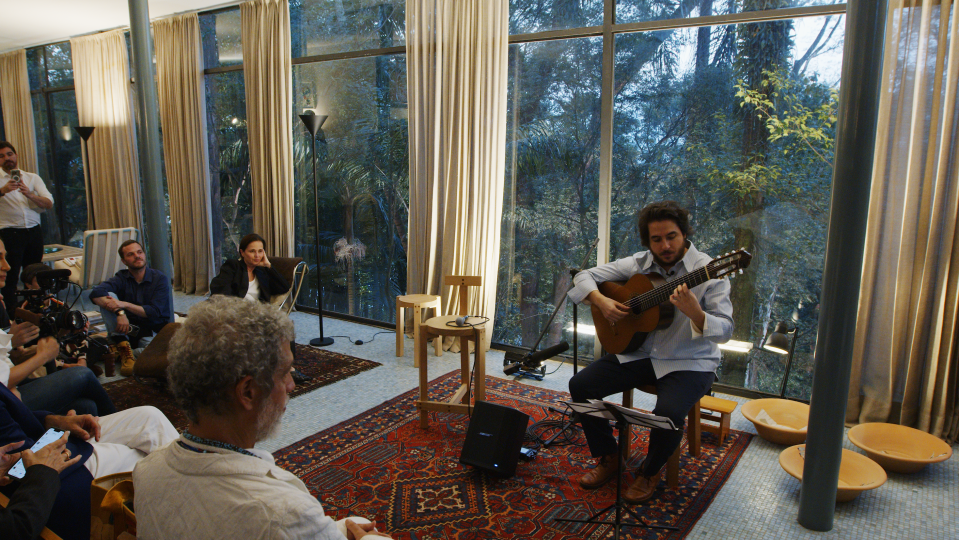Matthieu Blazy on Bottega Veneta, Craft, Art and Being Surprised

MILAN — Matthieu Blazy wants to be surprised, which is something he believes will lead to always fresh creativity.
In this vein, Blazy, creative director of Bottega Veneta, just returned from a trip to S?o Paulo, where the brand held the latest chapter in its cultural exchange series The Square. Bottega Veneta touched down in the Brazilian city after Dubai and Tokyo last year, celebrating local culture at Lina Bo Bardi’s iconic Casa de Vidro, or Glass House in English.
More from WWD
“As a global brand, when we started The Square in Dubai, we were looking to speak to a different audience,” Blazy, soft-spoken and thoughtfully choosing his words, explained in an exclusive interview.
“Often brands hold events to present their products, but I find it more interesting to start a conversation in a different country, where the event is more local, in a shared way, where the experience does not depend on the product, and inviting a diverse group of people who are experts in their own field.”
The Square series brings together artists, guests and the public in immersive, site-specific events that aim to stimulate curiosity and dialogue while championing Bottega Veneta’s values of craft, creativity and self-expression, he explained.
The Square S?o Paulo, which also marked Bottega Veneta’s 10-year anniversary in Brazil and celebrated the partnership with leading luxury developer Iguatemi, was curated with Mari Stockler. Blazy was adamant that he did not want “just a party or a store event [to signal the milestone]; I think it’s very, very boring.”
Following the the custom square structures of Dubai and Tokyo, the event was held in the square setting of Bo Bardi’s landmark Modernist house, surrounded by a lush garden.

Blazy enthused about Bo Bardi, revealing his longtime passion for the work of the late Italian-born architect and still marveling at the opportunity to stage the experience in her house.
He gave Stockler carte blanche. “What she did was incredible and also very generous, she put herself in Bo Bardi’s shoes and looked at the different horizons of creation in Brazil. Not just fine art, but also sculpture and music, gathering the artists in the house, as Bo Bardi would have done.”
Casa de Vidro was Bo Bardi’s first built project and personal residence until her death in 1992. Completed in 1951, the house has been a meeting point for artists, architects and intellectuals both during Bo Bardi’s lifetime, and subsequently under the direction of the Instituto Bardi/Casa de Vidro.
Through the 11-day program that kicked off on May 24, artists and artworks from Brazil came together to honor the legacy of Bo Bardi, explore her interaction with Brazilian culture, and celebrate Brazilian creativity in all its forms.

Blazy enjoys visiting art fairs, such as Frieze, for example, and knew about Stockler’s work through these events, he said. With her help, while he was knowledgeable in Brazilian art, he said he “discovered many others, and I trusted Mari to bring a new point of view. She went to Amazonia and found an incredible artist. I placed myself as a spectator as I was interested to learn as well. We have to trust the people we entitle; I don’t want to fall into the mono-vision of me driving the car,” underscored Blazy. “It’s not in the DNA of the company.”
The brand was founded by Michele Taddei and Renzo Zengiaro, who were followed by owners Laura Braggion and Vittorio Moltedo before Gucci Group’s acquisition in 2001.
“Choosing Mari allowed to bring diversity to the project, a different point of view and for me to be surprised,” Blazy continued.
The initial idea was to celebrate Bo Bardi’s legacy. “There are a lot of things you read in books, but I had not fully experienced her space. Then I sat in her chair, I saw how she [designed the concrete and glass structure] of the Museum of Art in S?o Paulo almost 70 years ago but she brought so much modernity.”
The museum’s main body is supported by two lateral beams over a 243-foot freestanding space. “She had a way to show the paintings on a concrete pedestal, on a glass which allows you to see the painting from front and back, and it‘s not at all didactic or following a timeline and you can choose your own pace.” He marveled at “the freedom she gives to the viewer, the simplicity of the design and the efficiency of it, so, yes, I was surprised.”
The surprise was extended to concretely experiencing Bo Bardi’s house. “You know that you are in a monument, it’s as if you were in a Le Corbusier [building] or in Machu Picchu, and it’s incredible architecturally but it’s very intimate at the same time. You feel it’s a domestic place; she was living there with her husband, you can imagine her in her house daily. Yes, it’s a place I would love to live in,” said Blazy, smiling. Bo Bardi cofounded the influential art magazine Habitat and also created jewelry, costume, furniture and set designs.
Blazy said that Bottega Veneta is “about timeless style” and that The Square “recognized how Lina’s ideas and aesthetics resonate to this day, always reminding us of the transformative power of design and culture.”

The event was curated around four themed pathways related to time; geometry and spirituality; Brazilian counterculture, and the roots of samba style Bossa Nova, taking visitors through the house and garden.
Participating talents in The Square S?o Paulo included Arnaldo Antunes, Ib? Salles, Vivian Caccuri, Luiz Zerbini, Carlito Carvalhosa, Rosana Paulino, Alaíde Costa, Lenora de Barros, Cristiano Lenhardt, Leda Catunda, Ricardo Aleixo, and Jo?o Camarero. The event also featured works by Lygia Pape, Hélio Oiticica, Augusto de Campos, Mestre Guarany, and Surubim Feliciano da Paix?o — as well as Bo Bardi’s own work, writings and original furnishings housed in Casa de Vidro.
Stockler decided to invite the artists into the house and not stage a traditional exhibition, but to immerse the works within the house as if Bo Bardi had chosen the pieces herself, said Blazy. “I believe [Bo Bardi] would have liked this approach,” he contended.
Stockler is “constantly digging for new artists,” said Blazy. He admitted knowing “the classic Brazilian artists and architecture,” but that he was eager to learn more. The experience “needed to have an angle, it’s not for me to have an opinion on what she is proposing, I am also challenged, and have to embrace what she offered.”
Four books, based on The Square’s four pathways, have been published in a limited-edition boxed set.
Blazy admitted he enjoys art, but he also underscored he does “not want to be seen just as intellectual or cerebral. I also like pop, you can talk a lot about art but in the end it’s about an emotion, does it trigger me, do I like it or not.”
He also disliked the idea of artists working directly on the clothes or on a bag. “I am not interested in this but I am in the idea of juxtaposition, almost like [the German artistic movement] Bauhaus working with people that can bring their stone to the edifice and when you combine voices, it can create something that is new.”
For Bottega Veneta’s spring 2023 collection, Blazy teamed with Gaetano Pesce, but he underscored that he worked on the clothes and Pesce on the set, leading to the juxtaposition. Pesce created 200 chairs for the show in Milan, each with a unique resin finish, some with hand drawings, which were then displayed at Design Miami and available for purchase.
For Milan’s Salone del Mobile last April, Pesce created limited edition handcrafted bags for Bottega Veneta — his first time designing bags — as part of the brand’s installation staged in a grotto made of resin and fabric. The bags were figurative, and more artworks than not, as the Intrecciato weave showed two mountains with a sunrise or sunset behind made with airbrush and crochet techniques.
“I thought it was more interesting that I remove myself and not be involved creatively in the bag. The sketch was from Gaetano and the bags were produced by Bottega Veneta; he worked directly with the artisans,” Blazy said.
The designer said inspiration comes from many different places and that he would not narrow it down to his passion for the arts, inherited from his parents, who both made a living out of it. “Yes, I look at art, I have met many artists in my life. But I also love stupid magazines; sometimes a great idea comes from looking at Coca Cola bottles in a café. But it’s true that because of my personal interest I will look maybe more at art than some movies. But inspiration is everywhere.”
Asked about his own artistic inclinations, he shyly said he paints, but underscored that it is merely a hobby and that he would not show his works to the outside world.
“The Square format gives us total freedom, it gives us the possibility to think without a product and it can go anywhere, and the good thing about anywhere is that culture is everywhere and there will always be something we can connect to,” said Blazy. “It can take a different shape depending on the location.”
He was pleased that The Square was open to the public in S?o Paulo and said the format was another way to have “great conversations” with his design team beyond the garments and accessories.
“We want to hold this kind of event once a year – and we need to work on it for a year, it’s not something you can do at the last minute. It’s a good challenge and helps us to try to think out of the box,” Blazy remarked. The next location has not been set yet.
Since his promotion to creative director in November 2021, succeeding Daniel Lee, Blazy has left his mark on Bottega Veneta with innovative and exciting designs and fabric manipulations, evolving the brand’s time-honed sophisticated leather techniques. He summed up his mantra with the simple statement that “craft is the essence” of the brand, and the handmade, artisanal skills are continuously stretched to find new ways to surprise the designer himself and the customer.
“The main idea is to deliver a great product, that is well made and that creates desire. If on top of that people call it fashion, then I am happy.”

Best of WWD
Solve the daily Crossword

